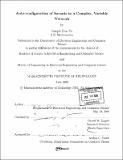| dc.contributor.advisor | Daniel W. Engels. | en_US |
| dc.contributor.author | Yu, Joseph Hon | en_US |
| dc.contributor.other | Massachusetts Institute of Technology. Dept. of Electrical Engineering and Computer Science. | en_US |
| dc.date.accessioned | 2006-07-13T15:19:29Z | |
| dc.date.available | 2006-07-13T15:19:29Z | |
| dc.date.copyright | 2005 | en_US |
| dc.date.issued | 2005 | en_US |
| dc.identifier.uri | http://hdl.handle.net/1721.1/33378 | |
| dc.description | Thesis (M. Eng. and S.B.)--Massachusetts Institute of Technology, Dept. of Electrical Engineering and Computer Science, 2005. | en_US |
| dc.description | Includes bibliographical references (p. 63-64). | en_US |
| dc.description.abstract | In this thesis, present a system design that enables Savants to automatically configure both their network settings and their required application programs when connected to an intelligent data management and application system. Savants are intelligent routers in a large network used to manage the data and events related to communications with electronic identification tags [10]. The ubiquitous nature of the identification tags and the access points that communicate with them requires an information and management system that is equally ubiquitous and able to deal with huge volumes of data. The Savant systems were designed to be such a ubiquitous information and management system. Deploying any ubiquitous system is difficult, and automation is required to streamline its deployment and improve system management, reliability, and performance. My solution to this auto-configuration problem uses NETCONF as a standard language and protocol for configuration communication among Savants. It also uses the Content-Addressable Network (CAN) as a discovery service to help Savants locate configuration information, since a new Savant may not have information about the network structure. With these tools, new Savants can configure themselves automatically with the help of other Savants. | en_US |
| dc.description.abstract | (cont.) Specifically, they can configure their network settings, download and set up software, and integrate with network distributed applications. Future work could expand upon my project by studying an implementation, making provisions for resource-limited Savants, or improving security. | en_US |
| dc.description.statementofresponsibility | by Joseph Hon Yu. | en_US |
| dc.format.extent | 64 p. | en_US |
| dc.format.extent | 2569339 bytes | |
| dc.format.extent | 2571914 bytes | |
| dc.format.mimetype | application/pdf | |
| dc.format.mimetype | application/pdf | |
| dc.language.iso | eng | en_US |
| dc.publisher | Massachusetts Institute of Technology | en_US |
| dc.rights | M.I.T. theses are protected by copyright. They may be viewed from this source for any purpose, but reproduction or distribution in any format is prohibited without written permission. See provided URL for inquiries about permission. | en_US |
| dc.rights.uri | http://dspace.mit.edu/handle/1721.1/7582 | |
| dc.subject | Electrical Engineering and Computer Science. | en_US |
| dc.title | Auto-configuration of Savants in a complex, variable network | en_US |
| dc.type | Thesis | en_US |
| dc.description.degree | M.Eng.and S.B. | en_US |
| dc.contributor.department | Massachusetts Institute of Technology. Department of Electrical Engineering and Computer Science | |
| dc.identifier.oclc | 62558485 | en_US |
